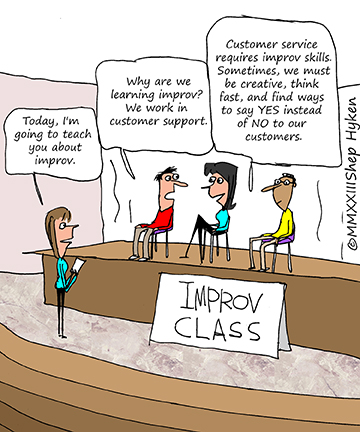
GUEST POST from Greg Satell
In 1957, Ken Olsen founded Digital Equipment Corporation (DEC) with his MIT classmate, Harlan Anderson, and by the 1960s, the company had pioneered the minicomputer revolution. Much cheaper than IBM mainframes, but still powerful enough to be useful, these machines helped make DEC one of the world’s leading technology companies.
Hailed as a visionary, Olson was named “America’s most successful entrepreneur” by Fortune magazine in 1986. Yet as AnnaLee Saxenian explained in Regional Advantage, by that time the minicomputer industry was already being disrupted by PC’s and DEC would never recover. It was acquired by Compaq in 1998.
The truth is that everybody gets disrupted eventually, even a visionary entrepreneur like Olsen. What makes the difference is whether you are able to chart a new path. That takes more than merely being smart and ambitious, you need to empower change from within. It’s never easy, but there are some basic principles that can help you reinvent your organization.
1.Identify A Keystone Change
Much like DEC in the 80s, by the 1990s IBM had hit hard times. Squeezed between low cost PC’s made by firms like Compaq, Intel based servers and a software industry dominated by Microsoft, IBM was near bankruptcy. Many observers, both inside and outside the company, thought that it should be broken up.
Yet its incoming CEO, Lou Gerstner, saw things differently. As a former customer, he knew how important IBM was to running critical business processes of large organizations. As he talked to other customers, he found they felt the same way. In fact, they were terrified of IBM being broken up. If he could refocus the company on fulfilling that need, he could save it.
That was easier said than done though. IBM had a hardwired culture of “if it was a good idea, we would have already done it” that had been ingrained over decades. So he needed to identify a keystone change — one that would be clear and tangible, involve multiple stakeholders and pave the way for future change — to make a transformation possible.
So Gerstner built a new business model aimed at the customers’ “stack of business processes” rather than its own “stack of proprietary technologies.” That led to a successful new service business, an e-business initiative and a new line of Linux based servers. Within a few years, he had achieved one of the greatest turnarounds in corporate history.
2. Empower Change Agents
Probably the greatest misconception about change is that a leader can force it through. Even as skilled an executive like Lou Gerstner needed others to actually implement the changes at IBM, his role was mostly to inspire belief that it could be done. The truth is that you can’t force change. You need need to attract rather than try to overpower.
As Zeynep Ton explains in The Good Jobs Strategy, when the recession hit in 2008, Mercadona, Spain’s leading discount retailer, needed to cut costs. But rather than cutting wages or reducing staff, they asked their employees to contribute ideas. The result was that the company managed to reduce prices by 10% and increased their market share from 15% to 20% between 2008 and 2012
Or consider England’s National Health Service, a truly mammoth organization of with 1.3 million employees serving 54 million citizens. In 2013 it introduced Change Day, on which employees pledge to do one thing to improve the life of patients. In that first year there were 189,000 pledges for action and that figure rose to 800,000 in the second year.
Many of the initiatives were small, but multiplied by hundreds of thousands, it has created a significant impact. As Helen Bevan, Chief Transformation Officer for the NHS Horizons team put it to me, “Programmatic methods have their place, but if you want to create change on a truly massive scale, a top-down approach on its own doesn’t work so well. You need to get people invested in change. They have to own it.”
3. Network Your Movement
When Rick Warren first arrived in Orange County, California in 1979, he saw the opportunity to build a new kind of church. He had spent three months going door-to-door and found that while many residents identified themselves as christians, they found church services boring and irrelevant. So he began to cater his services and programs to meet their needs.
Today, his Saddleback Church is one of the largest congregations in the world, with 20,000 people attending sermons every week. Yet looks can be deceiving. What makes Warren such a powerful force isn’t those massive weekend services, but the thousands of small prayer groups that that meet during the week.
We tend to think of effective leaders as solitary figures, able to compel action through sheer force of will, but actually they are shrewd managers of complex ecosystems and that’s key to how they are able to empower transformational change. Martin Luther King Jr., for example, didn’t lead the charge for civil rights alone, but as one of the Big Six. In much the same way, Nelson Mandela had to build consensus among many competing interests within the African National Congress.
Today IBM, having had its core business disrupted by the cloud, is taking a network approach to quantum computing. Rather than having its scientists work alone in secret labs, it has set up a Q Network of leading companies, startups, academic institutions, and national research labs to advance the technology.
4. Survive Victory
The most important thing to remember is that the battle against disruption never ends. All too often, an initial victory soon reverses itself. Many turnaround efforts see some initial improvement as excitement about a new direction motivates people to perform better, then dissipates as harsh realities take hold.
The case of Ken Olsen and DEC provides some insight into why this happens. While he was hailed as a visionary leader, the minicomputer revolution he spawned was rooted in a particular technology. When that technology ceased to be compelling, as always happens eventually, his company could no longer compete effectively.
Now consider what Irving Wladawsky-Berger, one of Gerster’s key lieutenants, told me about IBM’s historic turnaround. “The Gerstner revolution wasn’t about technology or strategy, it was about transforming our values and our culture to be in greater harmony with the market… Because the transformation was about values first and technology second, we were able to continue to embrace those values as the technology and marketplace continued to evolve.”
That’s why, as I explain in my book Cascades, it’s critical that you make a plan to survive victory and that plan must be rooted in fundamental values rather than in a particular strategy or set of tactics. To overcome disruption for the long-term, you need to not just transform the organization but, more importantly, the fundamental beliefs that drive it.
— Article courtesy of the Digital Tonto blog
— Image credit: Unsplash
 Sign up here to join 17,000+ leaders getting Human-Centered Change & Innovation Weekly delivered to their inbox every week.
Sign up here to join 17,000+ leaders getting Human-Centered Change & Innovation Weekly delivered to their inbox every week.
 Drum roll please…
Drum roll please…![]() Sign up here to get Human-Centered Change & Innovation Weekly delivered to your inbox every week.
Sign up here to get Human-Centered Change & Innovation Weekly delivered to your inbox every week.



